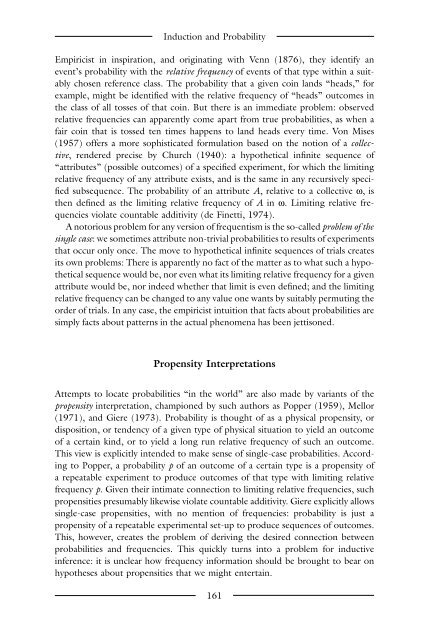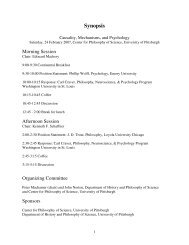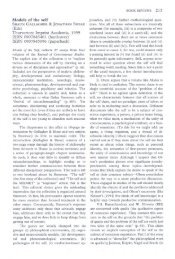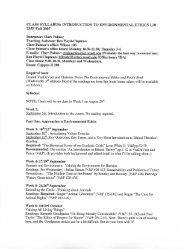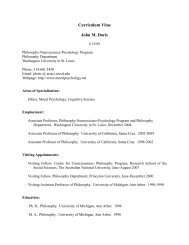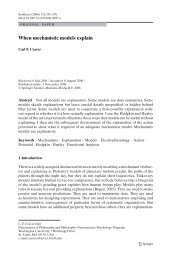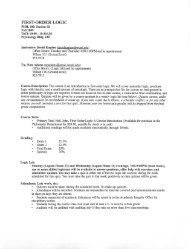The Blackwell Guide to the Philosophy of Science - The Department ...
The Blackwell Guide to the Philosophy of Science - The Department ...
The Blackwell Guide to the Philosophy of Science - The Department ...
You also want an ePaper? Increase the reach of your titles
YUMPU automatically turns print PDFs into web optimized ePapers that Google loves.
Induction and Probability<br />
Empiricist in inspiration, and originating with Venn (1876), <strong>the</strong>y identify an<br />
event’s probability with <strong>the</strong> relative frequency <strong>of</strong> events <strong>of</strong> that type within a suitably<br />
chosen reference class. <strong>The</strong> probability that a given coin lands “heads,” for<br />
example, might be identified with <strong>the</strong> relative frequency <strong>of</strong> “heads” outcomes in<br />
<strong>the</strong> class <strong>of</strong> all <strong>to</strong>sses <strong>of</strong> that coin. But <strong>the</strong>re is an immediate problem: observed<br />
relative frequencies can apparently come apart from true probabilities, as when a<br />
fair coin that is <strong>to</strong>ssed ten times happens <strong>to</strong> land heads every time. Von Mises<br />
(1957) <strong>of</strong>fers a more sophisticated formulation based on <strong>the</strong> notion <strong>of</strong> a collective,<br />
rendered precise by Church (1940): a hypo<strong>the</strong>tical infinite sequence <strong>of</strong><br />
“attributes” (possible outcomes) <strong>of</strong> a specified experiment, for which <strong>the</strong> limiting<br />
relative frequency <strong>of</strong> any attribute exists, and is <strong>the</strong> same in any recursively specified<br />
subsequence. <strong>The</strong> probability <strong>of</strong> an attribute A, relative <strong>to</strong> a collective w, is<br />
<strong>the</strong>n defined as <strong>the</strong> limiting relative frequency <strong>of</strong> A in w. Limiting relative frequencies<br />
violate countable additivity (de Finetti, 1974).<br />
A no<strong>to</strong>rious problem for any version <strong>of</strong> frequentism is <strong>the</strong> so-called problem <strong>of</strong> <strong>the</strong><br />
single case: we sometimes attribute non-trivial probabilities <strong>to</strong> results <strong>of</strong> experiments<br />
that occur only once. <strong>The</strong> move <strong>to</strong> hypo<strong>the</strong>tical infinite sequences <strong>of</strong> trials creates<br />
its own problems: <strong>The</strong>re is apparently no fact <strong>of</strong> <strong>the</strong> matter as <strong>to</strong> what such a hypo<strong>the</strong>tical<br />
sequence would be, nor even what its limiting relative frequency for a given<br />
attribute would be, nor indeed whe<strong>the</strong>r that limit is even defined; and <strong>the</strong> limiting<br />
relative frequency can be changed <strong>to</strong> any value one wants by suitably permuting <strong>the</strong><br />
order <strong>of</strong> trials. In any case, <strong>the</strong> empiricist intuition that facts about probabilities are<br />
simply facts about patterns in <strong>the</strong> actual phenomena has been jettisoned.<br />
Propensity Interpretations<br />
Attempts <strong>to</strong> locate probabilities “in <strong>the</strong> world” are also made by variants <strong>of</strong> <strong>the</strong><br />
propensity interpretation, championed by such authors as Popper (1959), Mellor<br />
(1971), and Giere (1973). Probability is thought <strong>of</strong> as a physical propensity, or<br />
disposition, or tendency <strong>of</strong> a given type <strong>of</strong> physical situation <strong>to</strong> yield an outcome<br />
<strong>of</strong> a certain kind, or <strong>to</strong> yield a long run relative frequency <strong>of</strong> such an outcome.<br />
This view is explicitly intended <strong>to</strong> make sense <strong>of</strong> single-case probabilities. According<br />
<strong>to</strong> Popper, a probability p <strong>of</strong> an outcome <strong>of</strong> a certain type is a propensity <strong>of</strong><br />
a repeatable experiment <strong>to</strong> produce outcomes <strong>of</strong> that type with limiting relative<br />
frequency p. Given <strong>the</strong>ir intimate connection <strong>to</strong> limiting relative frequencies, such<br />
propensities presumably likewise violate countable additivity. Giere explicitly allows<br />
single-case propensities, with no mention <strong>of</strong> frequencies: probability is just a<br />
propensity <strong>of</strong> a repeatable experimental set-up <strong>to</strong> produce sequences <strong>of</strong> outcomes.<br />
This, however, creates <strong>the</strong> problem <strong>of</strong> deriving <strong>the</strong> desired connection between<br />
probabilities and frequencies. This quickly turns in<strong>to</strong> a problem for inductive<br />
inference: it is unclear how frequency information should be brought <strong>to</strong> bear on<br />
hypo<strong>the</strong>ses about propensities that we might entertain.<br />
161


